Document Outline
- FEATURES
- GENERAL DESCRIPTION
- QUICK REFERENCE DATA
- ORDERING INFORMATION
- BLOCK DIAGRAM
- FUNCTIONAL DESCRIPTION
- PINNING
- LIMITING VALUES
- THERMAL CHARACTERISTICS
- CHARACTERISTICS
- PACKAGE OUTLINES
- SOLDERING
- DEFINITIONS
- LIFE SUPPORT APPLICATIONS
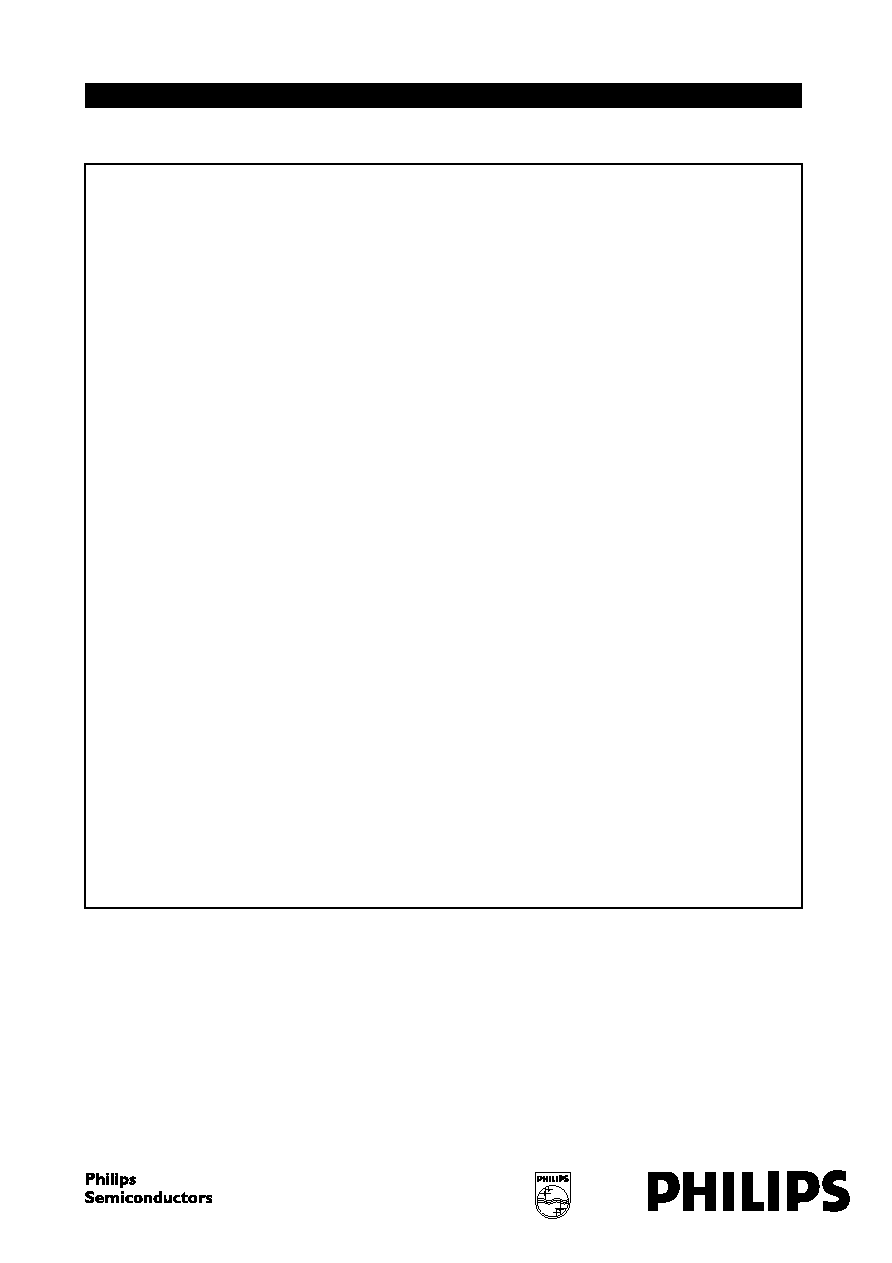
DATA SHEET
Product specification
Supersedes data of January 1994
File under Integrated Circuits, IC01
1995 Dec 15
INTEGRATED CIRCUITS
TDA8579
Dual common-mode rejection
differential line receiver

1995 Dec 15
2
Philips Semiconductors
Product specification
Dual common-mode rejection
differential line receiver
TDA8579
FEATURES
∑
Excellent common-mode rejection, up to high
frequencies
∑
Elimination of source resistance dependency in the
common-mode rejection
∑
Few external components
∑
High supply voltage ripple rejection
∑
Low noise
∑
Low distortion
∑
All pins protected against electrostatic discharge
∑
AC and DC short-circuit safe to ground and V
CC
∑
Fast DC settling.
GENERAL DESCRIPTION
The TDA8579 is a two channel differential amplifier with
0 dB gain and low distortion. The device has been
primarily developed for car radio applications where long
connections between signal sources and amplifiers (or
boosters) are necessary and where ground noise has to be
eliminated. The device is intended to be used to receive
line inputs in audio applications that require a high level of
common-mode rejection. The device is contained in an
8-pin small outline (SO) or dual in-line (DIP) package.
QUICK REFERENCE DATA
ORDERING INFORMATION
SYMBOL
PARAMETER
CONDITIONS
MIN.
TYP.
MAX.
UNIT
V
CC
supply voltage
5.0
8.5
18
V
I
CC
supply current
V
CC
= 8.5 V
-
11
14
mA
G
v
voltage gain
-
0.5
0
+0.5
dB
SVRR
supply voltage ripple rejection
55
60
-
dB
V
no
noise output voltage
-
3.7
5.0
µ
V
Z
i
input impedance
100
240
-
k
CMRR
common-mode rejection ratio
R
s
= 0
-
80
-
dB
TYPE
NUMBER
PACKAGE
NAME
DESCRIPTION
VERSION
TDA8579
DIP8
plastic dual in-line package; 8 leads (300 mil)
SOT97-1
TDA8579T
SO8
plastic small outline package; 8 leads; body width 3.9 mm
SOT96-1

1995 Dec 15
3
Philips Semiconductors
Product specification
Dual common-mode rejection
differential line receiver
TDA8579
BLOCK DIAGRAM
Fig.1 Block diagram.
MBD230
TDA8579
VCC
7
4
6
1
2
3
8
V
CC
GND
INR
INL
IN
OUTL
SVRR
OUTR
5
FUNCTIONAL DESCRIPTION
The TDA8579 contains two identical differential amplifiers
with a voltage gain of 0 dB. The device is intended to
receive line input signals for audio applications. The
TDA8579 has a very high level of common-mode rejection
and thus eliminates ground noise. The common-mode
rejection remains constant up to high frequencies (the
amplifier gain is fixed at 0 dB). The inputs have a high input
impedance. The output stage is a class AB stage with a
low output impedance. For a large common-mode
rejection, also at low frequencies, an electrolytic capacitor
connected to the negative input is advised. Because the
input impedance is relatively high, this results in a large
settling time of the DC input voltage. Therefore a
quick-charge circuit is included to charge the input
capacitor within 0.2 seconds.
All input and output pins are protected against high
electrostatic discharge conditions (4000 V, 150 pF, 150
).
PINNING
SYMBOL
PIN
DESCRIPTION
INL+
1
positive input left
IN
-
2
common negative input
INR+
3
positive input right
SVRR
4
half supply voltage
GND
5
ground
OUTR
6
output right
OUTL
7
output left
V
CC
8
supply voltage
Fig.2 Pin configuration.
1
2
3
4
8
7
6
5
TDA8579
INR
IN
INL
SVRR
GND
OUTR
OUTL
V CC
MBD231
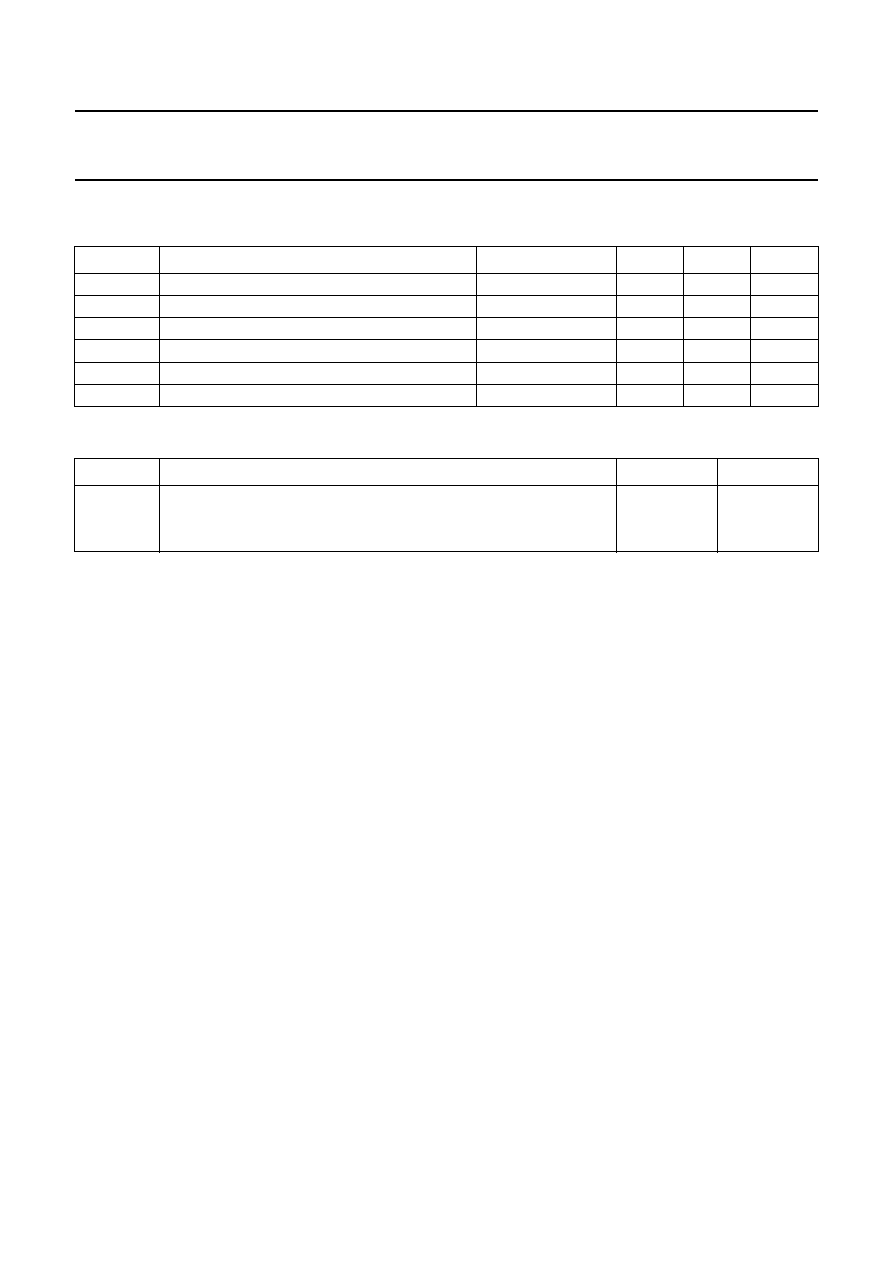
1995 Dec 15
4
Philips Semiconductors
Product specification
Dual common-mode rejection
differential line receiver
TDA8579
LIMITING VALUES
in accordance with the Absolute Maximum Rating System (IEC 134).
THERMAL CHARACTERISTICS
SYMBOL
PARAMETER
CONDITIONS
MIN.
MAX.
UNIT
V
CC
supply voltage
operating
-
18
V
I
ORM
repetitive peak output current
-
40
mA
V
sc
AC and DC short-circuit safe voltage
-
18
V
T
stg
storage temperature
-
55
+150
∞
C
T
amb
operating ambient temperature
-
40
+85
∞
C
T
j
maximum junction temperature
-
+150
∞
C
SYMBOL
PARAMETER
VALUE
UNIT
R
th j-a
thermal resistance from junction to ambient in free air
TDA8579 (DIP8)
110
K/W
TDA8579T (SO8)
160
K/W
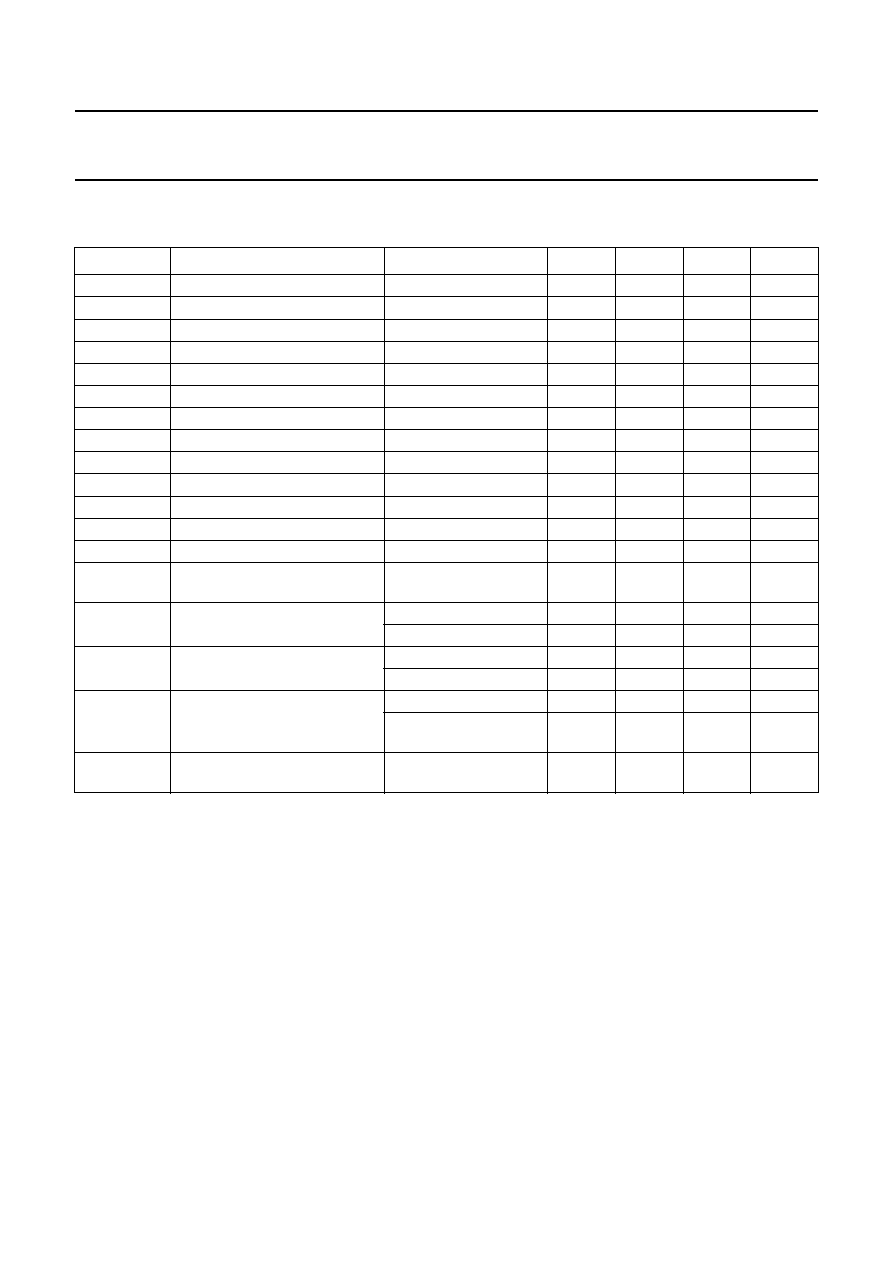
1995 Dec 15
5
Philips Semiconductors
Product specification
Dual common-mode rejection
differential line receiver
TDA8579
CHARACTERISTICS
V
CC
= 8.5 V; T
amb
= 25
∞
C; f = 1 kHz; measured in test circuit of Fig.3; unless otherwise specified.
Notes
1. The DC output voltage with respect to ground is approximately 0.5V
CC
.
2. The frequency response is externally fixed by the input coupling capacitors.
3. The noise output voltage is measured in a bandwidth of 20 Hz to 20 kHz (unweighted).
4. The common-mode rejection ratio is measured at the output with a voltage source 1 V (RMS) in accordance with the
test circuit (see Fig.3) while V
INL
and V
INR
are short-circuited. Frequencies between 100 Hz and 100 kHz.
5. The ripple rejection is measured at the output, with R
s
= 2 k
, f = 1 kHz and a ripple amplitude of 2 V (p-p).
6. The ripple rejection is measured at the output, with R
s
= 0 to 2 k
, f = 100 Hz to 20 kHz and a maximum ripple
amplitude of 2 V (p-p).
SYMBOL
PARAMETER
CONDITIONS
MIN.
TYP.
MAX.
UNIT
V
CC
supply voltage
5.0
8.5
18
V
I
CC
supply current
-
11
14
mA
V
O
DC output voltage
note 1
-
4.3
-
V
t
set
DC input voltage settling time
-
0.2
-
s
G
v
voltage gain
-
0.5
0
+0.5
dB
cs
channel separation
R
s
= 5 k
70
80
-
dB
G
v
channel unbalance
-
-
0.5
dB
f
L
low frequency roll-off
-
1 dB; note 2
20
-
-
Hz
f
H
high frequency roll-off
-
1 dB
20
-
-
kHz
Z
i
input impedance
100
240
-
k
Z
o
output impedance
-
-
10
V
i(max)
maximum input voltage
THD = 1%
-
2.0
-
V
V
no
noise output voltage
R
s
= 0
; note 3
-
3.7
5.0
µ
V
V
CM(rms)
common-mode input voltage
(RMS value)
-
-
1.0
V
CMRR
common-mode rejection ratio
R
s
= 5 k
66
70
-
dB
R
s
= 0
; note 4
-
80
-
dB
SVRR
supply voltage ripple rejection
note 5
55
65
-
dB
note 6
-
60
-
dB
THD
total harmonic distortion
V
i
= 1 V;
-
0.02
-
%
V
i
= 1 V;
f = 20 Hz to 20 kHz
-
-
0.1
%
THD
max
total harmonic distortion at
maximum output current
V
i
= 1 V; R
L
= 150
-
-
1
%
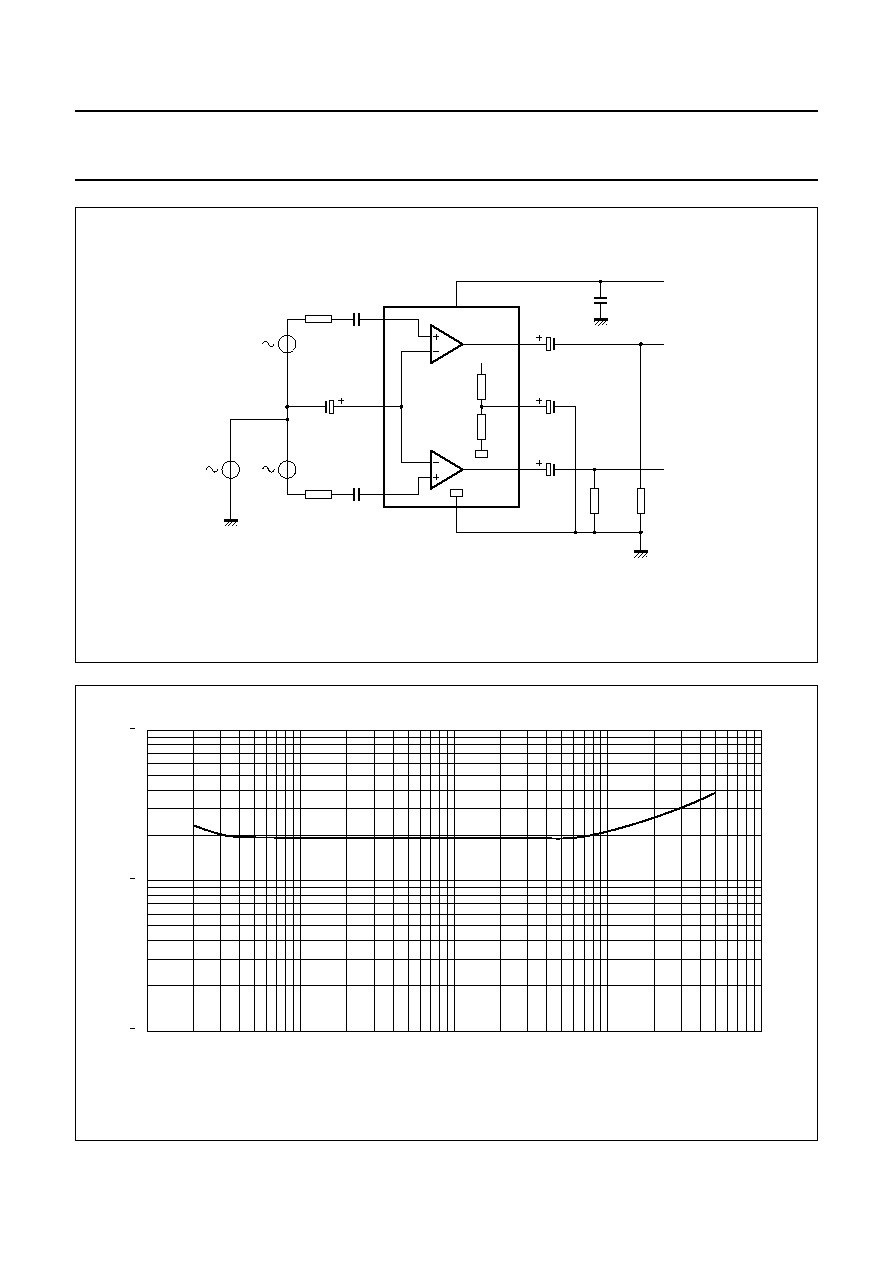
1995 Dec 15
6
Philips Semiconductors
Product specification
Dual common-mode rejection
differential line receiver
TDA8579
Fig.3 Test and application circuit.
MBD232
VCC
7
4
6
1
2
3
5
8
OUTL
OUTR
47
µ
F
2.2
µ
F
2.2
µ
F
R L
10 k
R L
10 k
100 nF
8.5 V
220 nF
R s
22
µ
F
VINR
5 k
220 nF
R s
5 k
VINL
TDA8579
SVRR
VCM
Fig.4 Total harmonic distortion as a function of frequency; V
i
= 1 V (RMS).
10
5
MBD215
10
4
10
3
10
2
10
10
1
10
2
10
3
f (Hz)
THD
(%)

1995 Dec 15
7
Philips Semiconductors
Product specification
Dual common-mode rejection
differential line receiver
TDA8579
100
0
10
5
MBD216
10
4
10
3
10
2
10
80
60
40
20
CMR
(dB)
f (Hz)
(1)
(2)
(3)
Fig.5 Common-mode rejection ratio as a function of frequency; V
CM
= 1 V (RMS).
(1) R
s
= 5 k
.
(2) R
s
= 2 k
.
(3) R
s
= 0 k
.
Fig.6 Total harmonic distortion as a function of input voltage; f = 1 kHz.
MBD213
10
10
2
1
10
1
THD
(%)
10
2
10
3
10
3
10
4
V (mV)
i (rms)

1995 Dec 15
8
Philips Semiconductors
Product specification
Dual common-mode rejection
differential line receiver
TDA8579
Fig.7 Common-mode rejection ratio as a function of common-mode input voltage; f = 1 kHz (R
s
= 0
).
1300
40
90
100
300
500
700
900
80
70
60
50
MBD214
CMR
(dB)
1100
V (mV)
CM (rms)
Fig.8 Common-mode rejection ratio as a function of frequency; V
CM
= 1 V (RMS).
(1) C2 = 22
µ
F.
(2) C2 = 47
µ
F.
(3) C2 = 100
µ
F.
100
0
10
5
MBD211
10
4
10
3
10
2
10
80
60
40
20
CMR
(dB)
(1)
(2)
(3)
f (Hz)
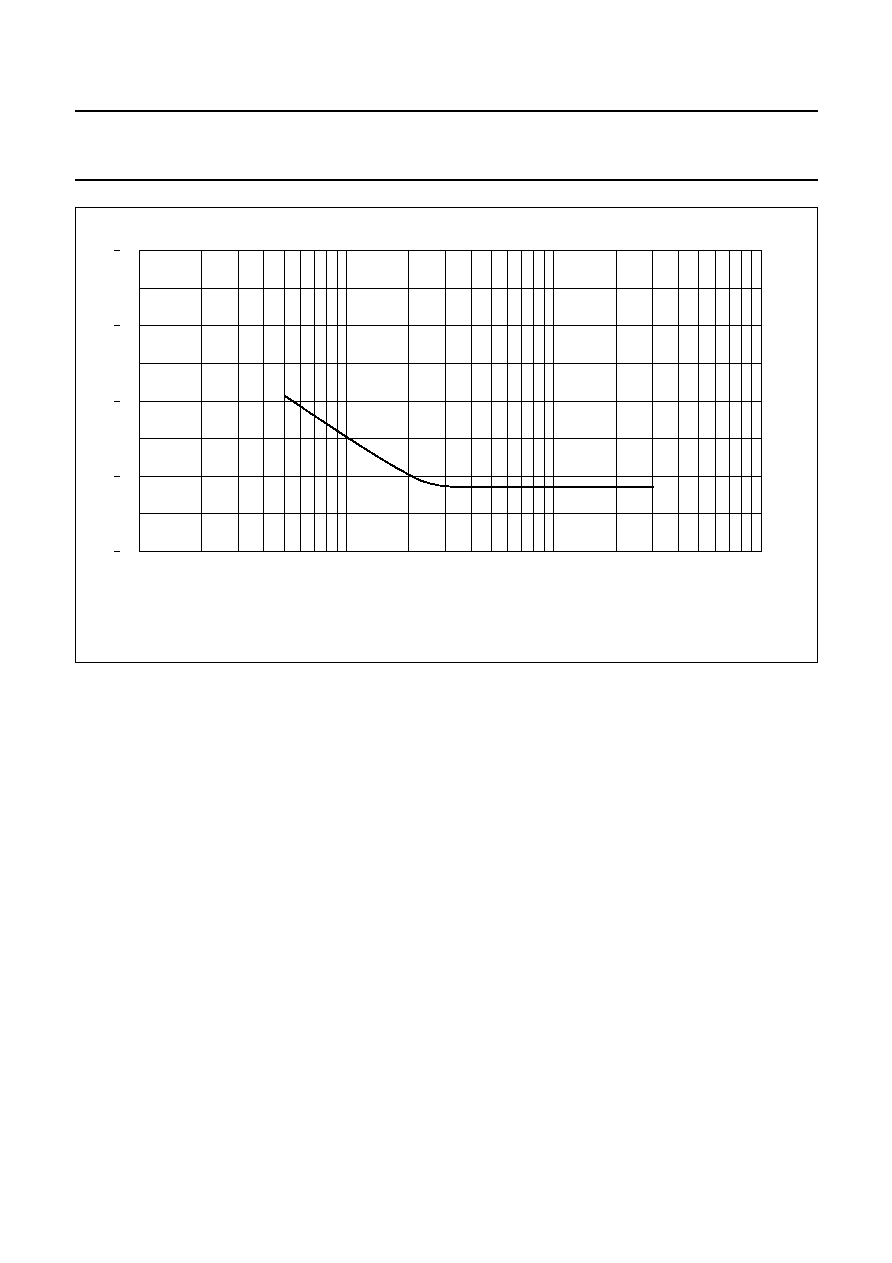
1995 Dec 15
9
Philips Semiconductors
Product specification
Dual common-mode rejection
differential line receiver
TDA8579
Fig.9 Supply voltage ripple rejection as a function of frequency; V
ripple
= 2 V (p-p), R
s
= 2 k
.
70
30
40
60
MBD212
10
4
10
3
10
2
10
50
SVR
(dB)
f (Hz)

1995 Dec 15
10
Philips Semiconductors
Product specification
Dual common-mode rejection
differential line receiver
TDA8579
PACKAGE OUTLINES
REFERENCES
OUTLINE
VERSION
EUROPEAN
PROJECTION
ISSUE DATE
IEC
JEDEC
EIAJ
SOT97-1
92-11-17
95-02-04
UNIT
A
max.
1
2
b
1
(1)
(1)
(1)
b
2
c
D
E
e
M
Z
H
L
mm
DIMENSIONS (inch dimensions are derived from the original mm dimensions)
A
min.
A
max.
b
max.
w
M
E
e
1
1.73
1.14
0.53
0.38
0.36
0.23
9.8
9.2
6.48
6.20
3.60
3.05
0.254
2.54
7.62
8.25
7.80
10.0
8.3
1.15
4.2
0.51
3.2
inches
0.068
0.045
0.021
0.015
0.014
0.009
1.07
0.89
0.042
0.035
0.39
0.36
0.26
0.24
0.14
0.12
0.01
0.10
0.30
0.32
0.31
0.39
0.33
0.045
0.17
0.020
0.13
b
2
050G01
MO-001AN
M
H
c
(e )
1
M
E
A
L
seating plane
A
1
w
M
b
1
e
D
A
2
Z
8
1
5
4
b
E
0
5
10 mm
scale
Note
1. Plastic or metal protrusions of 0.25 mm maximum per side are not included.
pin 1 index
DIP8: plastic dual in-line package; 8 leads (300 mil)
SOT97-1

1995 Dec 15
11
Philips Semiconductors
Product specification
Dual common-mode rejection
differential line receiver
TDA8579
UNIT
A
max.
A
1
A
2
A
3
b
p
c
D
(1)
E
(2)
(1)
e
H
E
L
L
p
Q
Z
y
w
v
REFERENCES
OUTLINE
VERSION
EUROPEAN
PROJECTION
ISSUE DATE
IEC
JEDEC
EIAJ
mm
inches
1.75
0.25
0.10
1.45
1.25
0.25
0.49
0.36
0.25
0.19
5.0
4.8
4.0
3.8
1.27
6.2
5.8
1.05
0.7
0.6
0.7
0.3
8
0
o
o
0.25
0.1
0.25
DIMENSIONS (inch dimensions are derived from the original mm dimensions)
Notes
1. Plastic or metal protrusions of 0.15 mm maximum per side are not included.
2. Plastic or metal protrusions of 0.25 mm maximum per side are not included.
1.0
0.4
SOT96-1
X
w
M
A
A
1
A
2
b
p
D
H
E
L
p
Q
detail X
E
Z
e
c
L
v
M
A
(A )
3
A
4
5
pin 1 index
1
8
y
076E03S
MS-012AA
0.069
0.010
0.004
0.057
0.049
0.01
0.019
0.014
0.0100
0.0075
0.20
0.19
0.16
0.15
0.050
0.244
0.228
0.028
0.024
0.028
0.012
0.01
0.01
0.041
0.004
0.039
0.016
0
2.5
5 mm
scale
SO8: plastic small outline package; 8 leads; body width 3.9 mm
SOT96-1
95-02-04
97-05-22

1995 Dec 15
12
Philips Semiconductors
Product specification
Dual common-mode rejection
differential line receiver
TDA8579
SOLDERING
Introduction
There is no soldering method that is ideal for all IC
packages. Wave soldering is often preferred when
through-hole and surface mounted components are mixed
on one printed-circuit board. However, wave soldering is
not always suitable for surface mounted ICs, or for
printed-circuits with high population densities. In these
situations reflow soldering is often used.
This text gives a very brief insight to a complex technology.
A more in-depth account of soldering ICs can be found in
our
"IC Package Databook" (order code 9398 652 90011).
DIP
S
OLDERING BY DIPPING OR BY WAVE
The maximum permissible temperature of the solder is
260
∞
C; solder at this temperature must not be in contact
with the joint for more than 5 seconds. The total contact
time of successive solder waves must not exceed
5 seconds.
The device may be mounted up to the seating plane, but
the temperature of the plastic body must not exceed the
specified maximum storage temperature (T
stg max
). If the
printed-circuit board has been pre-heated, forced cooling
may be necessary immediately after soldering to keep the
temperature within the permissible limit.
R
EPAIRING SOLDERED JOINTS
Apply a low voltage soldering iron (less than 24 V) to the
lead(s) of the package, below the seating plane or not
more than 2 mm above it. If the temperature of the
soldering iron bit is less than 300
∞
C it may remain in
contact for up to 10 seconds. If the bit temperature is
between 300 and 400
∞
C, contact may be up to 5 seconds.
SO
R
EFLOW SOLDERING
Reflow soldering techniques are suitable for all SO
packages.
Reflow soldering requires solder paste (a suspension of
fine solder particles, flux and binding agent) to be applied
to the printed-circuit board by screen printing, stencilling or
pressure-syringe dispensing before package placement.
Several techniques exist for reflowing; for example,
thermal conduction by heated belt. Dwell times vary
between 50 and 300 seconds depending on heating
method. Typical reflow temperatures range from
215 to 250
∞
C.
Preheating is necessary to dry the paste and evaporate
the binding agent. Preheating duration: 45 minutes at
45
∞
C.
W
AVE SOLDERING
Wave soldering techniques can be used for all SO
packages if the following conditions are observed:
∑
A double-wave (a turbulent wave with high upward
pressure followed by a smooth laminar wave) soldering
technique should be used.
∑
The longitudinal axis of the package footprint must be
parallel to the solder flow.
∑
The package footprint must incorporate solder thieves at
the downstream end.
During placement and before soldering, the package must
be fixed with a droplet of adhesive. The adhesive can be
applied by screen printing, pin transfer or syringe
dispensing. The package can be soldered after the
adhesive is cured.
Maximum permissible solder temperature is 260
∞
C, and
maximum duration of package immersion in solder is
10 seconds, if cooled to less than 150
∞
C within
6 seconds. Typical dwell time is 4 seconds at 250
∞
C.
A mildly-activated flux will eliminate the need for removal
of corrosive residues in most applications.
R
EPAIRING SOLDERED JOINTS
Fix the component by first soldering two diagonally-
opposite end leads. Use only a low voltage soldering iron
(less than 24 V) applied to the flat part of the lead. Contact
time must be limited to 10 seconds at up to 300
∞
C. When
using a dedicated tool, all other leads can be soldered in
one operation within 2 to 5 seconds between
270 and 320
∞
C.
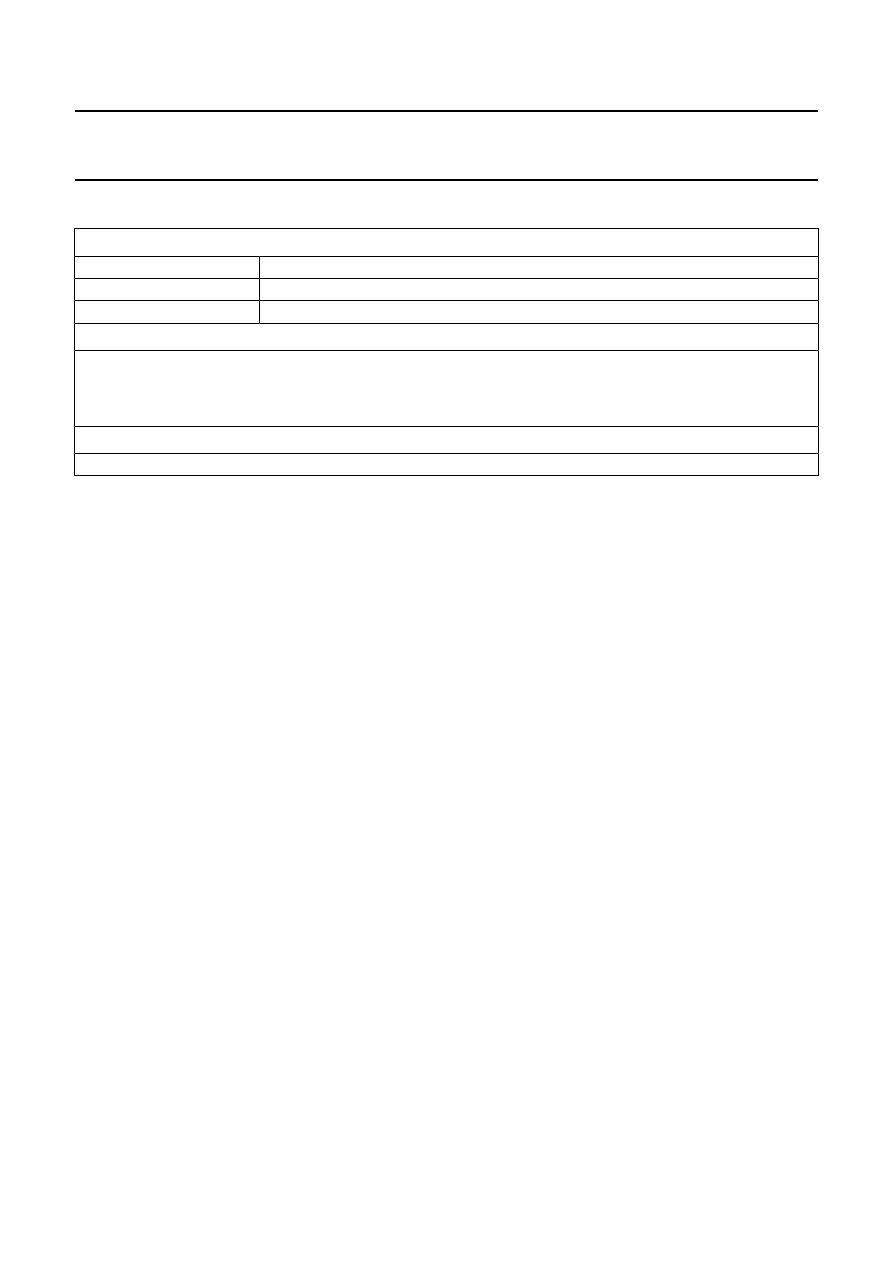
1995 Dec 15
13
Philips Semiconductors
Product specification
Dual common-mode rejection
differential line receiver
TDA8579
DEFINITIONS
LIFE SUPPORT APPLICATIONS
These products are not designed for use in life support appliances, devices, or systems where malfunction of these
products can reasonably be expected to result in personal injury. Philips customers using or selling these products for
use in such applications do so at their own risk and agree to fully indemnify Philips for any damages resulting from such
improper use or sale.
Data sheet status
Objective specification
This data sheet contains target or goal specifications for product development.
Preliminary specification
This data sheet contains preliminary data; supplementary data may be published later.
Product specification
This data sheet contains final product specifications.
Limiting values
Limiting values given are in accordance with the Absolute Maximum Rating System (IEC 134). Stress above one or
more of the limiting values may cause permanent damage to the device. These are stress ratings only and operation
of the device at these or at any other conditions above those given in the Characteristics sections of the specification
is not implied. Exposure to limiting values for extended periods may affect device reliability.
Application information
Where application information is given, it is advisory and does not form part of the specification.












